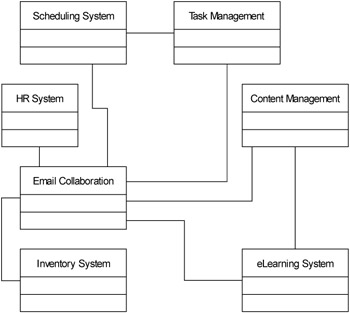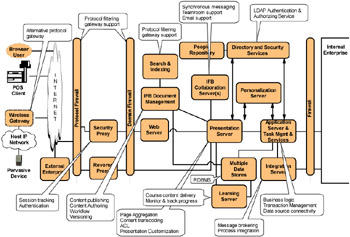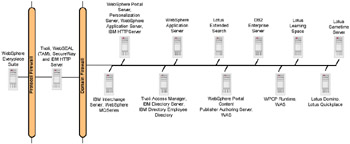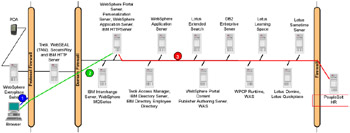4.5 Execute (develop the physical design)
|
| < Day Day Up > |
|
4.5 Execute (develop the physical design)
Step 3A-C [3]
The Component Relationship Diagram for IFB is shown in Figure 4-14 on page 190.

Figure 4-14: IFB component relationship diagram
Component interaction diagrams are useful to understand the details of the interaction between components in supporting use cases.

Figure 4-15: IFB component interaction diagram-Update personnel information
Figure 4-16 on page 192 identifies the software services associated with each of the logical nodes. This is in preparation for mapping to software products that provide those services as well as mapping software components to physical nodes in an operational model.

Figure 4-16: IFB AOD with identified software services
Step 3D - Develop the Operational Model
Figure 4-16 show an initial operational model with the assignment of software services to software products mapped to physical nodes. One important operational model decision not visible in Figure 4-16 is the use of the WebSphere Portal Application Integration framework to provide direct integration with the PeopleSoft back-end systems from the portal server.
Step 3E - Seed the Operational Model
Figure 4-17 on page 193 shows product mappings applied to the Operational Model.

Figure 4-17: IFB Operational Model
Step 3F - Address operational NFRs in the Operational Model
None of the NFRs require any specific modification of the operational model. The response-time NFRs may affect machine sizing. With the exception of the access restriction to both POS and kiosk devices, the security NFRs are covered by Tivoli Access Manager. Access management is controlled through specific roles established for each device type, with access rights architected to enforce security requirements.
Step 3G - Conduct technical walkthroughs to ensure that NFRs are met
Figure 4-18 on page 194 and Table 4-8 on page 194 together describe a walkthrough of the Operational Model, validating coverage of the Single Sign-On NFR.
| Step 1 | Associate gets prompted for portal credentials from WebSEAL |
| Step 2 | Credentials are provided to portal, and the Associate navigates to the HR page to request information about his/her current personnel profile |
| Step 3 | PeopleSoft portlet (WebSphere Portal Application Integration) accesses the Portal Credential Vault to retrieve the PeopleSoft credential for the Associate. This credential is presented to the PeopleSoft application, along with the request for the personnel profile data. |

Figure 4-18: SSO walkthrough using Operational Model
[3]Step 3A - Build the Component Model
Step 3B - Apply design guidelines (application level) from matched large reusable assets solution:development methodology:
Step 3C - Conduct technical walkthrough of component interaction
|
| < Day Day Up > |
|
EAN: 2147483647
Pages: 82